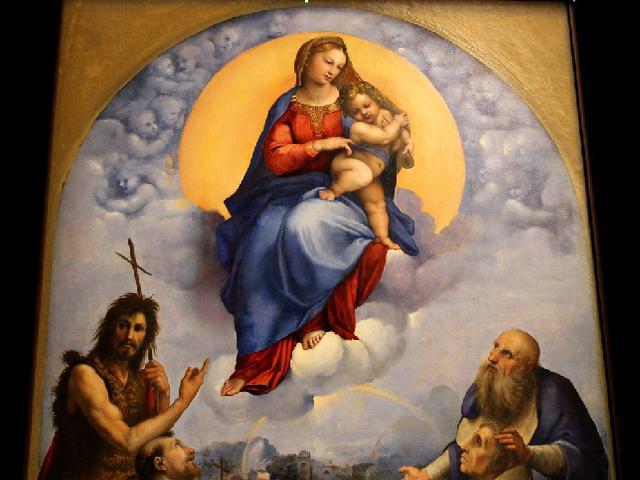The Madonna De Foligno

The Madonna De Foligno is a renowned painting by the Italian Renaissance artist Raphael Sanzio, completed in 1512. This masterpiece was commissioned by Sigismondo de' Conti, the secretary of Pope Julius II, to commemorate a miraculous event that occurred in Foligno. According to the legend, the donor's house in Foligno was struck by lightning during a storm, but miraculously remained undamaged. Another version of the story suggests that the house was hit by a projectile during the Foligno siege.
This oil painting on board was later transferred to canvas, showcasing Raphael's exceptional skill in composition and his ability to create a harmonious balance between the celestial and earthly realms. The central focus of the painting is the Virgin Mary and the infant Jesus, surrounded by a host of angels on a cloud. The figures are framed by an orange disk, symbolizing divine light, and are elevated above a group of saints, including the kneeling donor. The celestial zone is distinguished by its vibrant colors and luminosity, creating a sense of transcendence and spirituality.
In the background of the painting, Raphael depicts a stormy landscape with a flash of lightning striking the Chigi Palace, a nod to the miraculous event that inspired the commission. The contrast between the heavenly and earthly realms is further emphasized by the use of chiaroscuro and the detailed characterization of the figures. The Madonna De Foligno is considered a masterpiece of Western art, showcasing Raphael's mature style and his ability to convey complex narratives through visual storytelling.
Visitors to the Vatican are captivated by the beauty and symbolism of the Madonna De Foligno, which is housed in the Pinacoteca Vaticana. The painting's intricate details, emotive figures, and dramatic composition continue to inspire awe and admiration centuries after its creation. As tourists explore the Vatican Museums, they are drawn to this iconic work of art, which serves as a testament to Raphael's enduring legacy as one of the greatest artists of the Renaissance. The Madonna De Foligno remains a must-see attraction for art enthusiasts and history buffs alike, offering a glimpse into the rich artistic heritage of Italy during the Renaissance period.
© ChatGPT 3.5
*It was commissioned to commemorate a miracle in which the donor's house, in Foligno, was struck by lightning or, according to another version, by a projectile during the siege of Foligno, without being damaged.
*Around 1688, the composition was reproduced in etching (engraving mode) by the Valencian artist and scholar Vicente Victoria.
*The work was taken as loot by the Napoleonic army and taken to Paris between 1797 or 1799; There, in 1801 it was converted from board to cloth. It was returned in 1815 to the monastery of Foligno, and became part of the Vatican Pinacoteca.
*A copy of this work is preserved in the cathedral of Foligno and is attributed to the painter Giulio Romano, after being restored.
*In 2014, the Philatelic and Numismatic Office of the Vatican, the issuing body of the state of the Church, commissioned the Polygraphic and Mental Institute of the State of Italy to mint in gold a commemorative coin of 100 euros dedicated to the Maddona di Foligno. Only 999 coins were minted.
*Also in 2014, and after several years of research, Luis Rodrigo Rodríguez Simón, professor of Fine Arts at the University of Granada, attributed the authorship of “Small Madonna of Foligno” to Rafael Sanzio, a painting that arrived in Córdoba in the last decades of the 19th century from France and which is an identical reproduction of the Foligno Madonna.